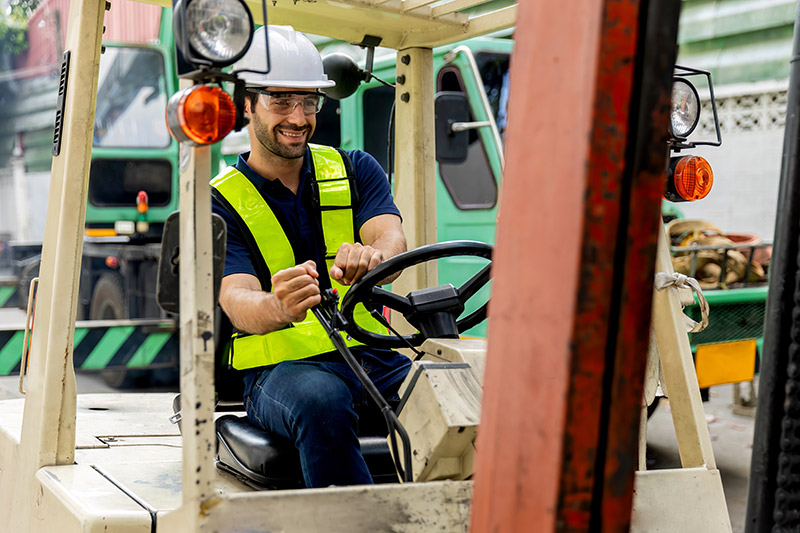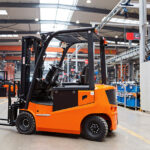Safety is paramount when operating heavy machinery. Forklifts, commonly used in industries like warehousing, construction, and shipping, can be hazardous if not handled correctly. Below is a guide on how to operate a forklift safely.
Note: Always cross-reference the information provided here with your compliance or training personnel to ensure no important steps are omitted.
Requirements to Operate a Forklift Safely
Operating a forklift involves more than just getting on and driving. It is governed by legal and safety standards.
- Age Restrictions: In the U.S., the minimum legal age to operate a forklift is 18, ensuring the operator possesses the necessary maturity and judgment for safe handling.
- Training and Certification: Federal law requires formal training and evaluation before operating a forklift. This includes classroom instruction, hands-on practice, and an evaluation.
- Refresher Training: Certification isn’t a one-time requirement. Operators must renew their certification every three years or undergo immediate retraining if involved in an accident, operating unsafely, or when a different type of forklift is introduced.
The Basics of Forklift Operation
Before starting the forklift, there are important pre-operation steps to take.
- Pre-Operation Inspection: At the start of each shift, inspect the forklift for leaks, damages, or malfunctioning parts. Ensure that tires are properly inflated and all safety features, like horns and lights, are working.
- Boarding the Forklift: Always approach the forklift from the side, using the handholds and steps to avoid slips or falls.
- Adjust Before Starting: After boarding, adjust the seat, mirrors, and controls for optimal visibility and control.
- Starting the Forklift: Start the forklift in neutral, with the parking brake engaged, to ensure safe operation.
Mastering Lift Techniques
Lifting safely is at the heart of forklift operation.
- Load Assessment: Evaluate the load before lifting, checking its stability and weight distribution. Secure it if necessary.
- Approach: Always approach the load head-on, as approaching from an angle may cause instability.
- Fork Positioning: Ensure the forks are set at the appropriate height and width for the load.
- Lifting and Moving: Lift the load carefully and keep it low while moving to maintain a low center of gravity.
- Tilting: Slightly tilt the mast backward once the load is lifted to stabilize it during transportation.
Basic Forklift Controls
Understanding and mastering the forklift’s controls is crucial for safe operation.
- Pedals: Forklifts have accelerator and brake pedals similar to cars. Some models include an inching pedal for precise movements.
- Steering: Forklift steering differs from cars, especially in models with rear-wheel steering. Practice in a controlled environment before taking on real tasks.
- Mast Controls: Familiarize yourself with mast controls for lifting, lowering, and tilting loads.
- Gearshift: If the forklift isn’t automatic, know how to properly shift gears.
- Safety Features: Use safety features like horns, lights, and backup alarms to communicate your movements to others.
Tips for Safe Forklift Operation
- Wear Safety Gear: Always wear a hard hat, safety shoes, and high-visibility clothing when operating a forklift.
- Follow Weight Limits: Never exceed the forklift’s rated capacity, as overloading can lead to tip-overs.
- Operate Smoothly: Avoid sudden stops, starts, or turns to prevent accidents.
- Maintain Clear Vision: If your load obstructs your view, drive in reverse or use a spotter for guidance.
- Use Your Horn: Make it a habit to honk at intersections, blind spots, or when reversing.
- No Passengers: Forklifts aren’t meant for passengers unless a seat is designated for them.
- Drive on Inclines Properly: Always ascend or descend slopes slowly and straight, never diagonally.
Understanding Forklift Stability
- Center of Gravity: When lifting a load, the forklift’s center of gravity shifts, which can affect its stability.
- The Stability Triangle: Forklifts have a three-point suspension system, creating a “stability triangle.” As long as the center of gravity remains within this triangle, the forklift stays stable.
Maintenance and Regular Checks
- Daily Checks: At the start of each shift, inspect the brakes, steering, controls, and safety devices.
- Scheduled Maintenance: Follow the manufacturer’s maintenance schedule to ensure safe and reliable forklift operation.
- Prompt Repairs: Never operate a forklift in need of repairs. Addressing issues promptly ensures safety and avoids higher repair costs.



